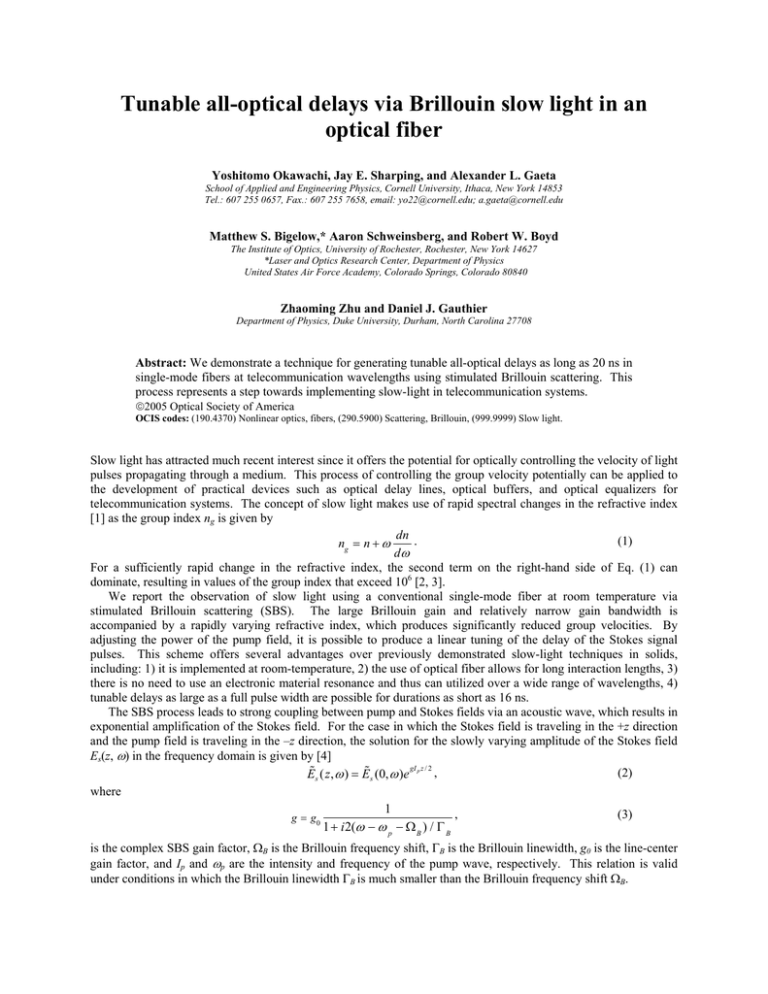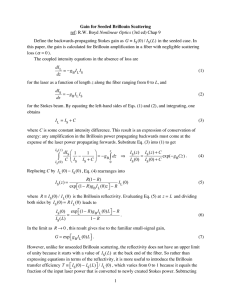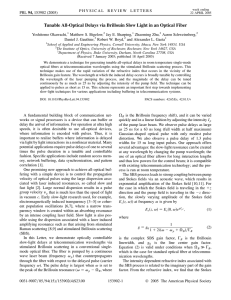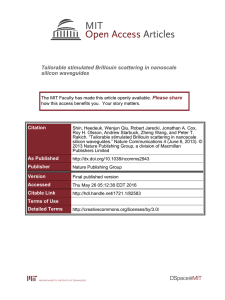Tunable all-optical delays via Brillouin slow light in an optical fiber
advertisement

Tunable all-optical delays via Brillouin slow light in an optical fiber Yoshitomo Okawachi, Jay E. Sharping, and Alexander L. Gaeta School of Applied and Engineering Physics, Cornell University, Ithaca, New York 14853 Tel.: 607 255 0657, Fax.: 607 255 7658, email: yo22@cornell.edu; a.gaeta@cornell.edu Matthew S. Bigelow,* Aaron Schweinsberg, and Robert W. Boyd The Institute of Optics, University of Rochester, Rochester, New York 14627 *Laser and Optics Research Center, Department of Physics United States Air Force Academy, Colorado Springs, Colorado 80840 Zhaoming Zhu and Daniel J. Gauthier Department of Physics, Duke University, Durham, North Carolina 27708 Abstract: We demonstrate a technique for generating tunable all-optical delays as long as 20 ns in single-mode fibers at telecommunication wavelengths using stimulated Brillouin scattering. This process represents a step towards implementing slow-light in telecommunication systems. ©2005 Optical Society of America OCIS codes: (190.4370) Nonlinear optics, fibers, (290.5900) Scattering, Brillouin, (999.9999) Slow light. Slow light has attracted much recent interest since it offers the potential for optically controlling the velocity of light pulses propagating through a medium. This process of controlling the group velocity potentially can be applied to the development of practical devices such as optical delay lines, optical buffers, and optical equalizers for telecommunication systems. The concept of slow light makes use of rapid spectral changes in the refractive index [1] as the group index ng is given by dn . (1) ng = n + ω dω For a sufficiently rapid change in the refractive index, the second term on the right-hand side of Eq. (1) can dominate, resulting in values of the group index that exceed 106 [2, 3]. We report the observation of slow light using a conventional single-mode fiber at room temperature via stimulated Brillouin scattering (SBS). The large Brillouin gain and relatively narrow gain bandwidth is accompanied by a rapidly varying refractive index, which produces significantly reduced group velocities. By adjusting the power of the pump field, it is possible to produce a linear tuning of the delay of the Stokes signal pulses. This scheme offers several advantages over previously demonstrated slow-light techniques in solids, including: 1) it is implemented at room-temperature, 2) the use of optical fiber allows for long interaction lengths, 3) there is no need to use an electronic material resonance and thus can utilized over a wide range of wavelengths, 4) tunable delays as large as a full pulse width are possible for durations as short as 16 ns. The SBS process leads to strong coupling between pump and Stokes fields via an acoustic wave, which results in exponential amplification of the Stokes field. For the case in which the Stokes field is traveling in the +z direction and the pump field is traveling in the –z direction, the solution for the slowly varying amplitude of the Stokes field Es(z, ω) in the frequency domain is given by [4] gI z / 2 (2) E s ( z , ω ) = E s (0, ω )e p , where 1 , (3) g = g0 1 + i2(ω − ω p − Ω B ) / Γ B is the complex SBS gain factor, ΩB is the Brillouin frequency shift, ΓB is the Brillouin linewidth, g0 is the line-center gain factor, and Ip and ωp are the intensity and frequency of the pump wave, respectively. This relation is valid under conditions in which the Brillouin linewidth ΓB is much smaller than the Brillouin frequency shift ΩB. The imaginary part of the gain factor (Eq. 3) describes the intensity-dependent refractive index change associated with the SBS process, from which we obtain the expression for the wavevector of the Stokes field. The group velocity is then given by vg = (dk/dω)-1. At the peak of the Brillouin gain, where the frequency of the Stokes field equals ωs = ωp − ΩB, the group velocity is given by n g0 I p . (4) v −1 = + g c ΓB The induced delay that can be obtained for a medium of length L is the difference between the values of L/vg with and without the pump field. Hence the total induced delay is g0 I p L G , (5) ∆Td = = ΓB ΓB where G = g0IpL is the gain parameter. This relation clearly illustrates that the induced delay can be controlled through the intensity of the pump wave. The experimental scheme for observing slow light via SBS is shown in Fig. 1. The amplified CW signal from the erbium-doped fiber amplifier (EDFA) is split in two and one of the signals is sent to an SBS generator consisting of a 1-km length of Corning SMF-28e fiber to produce the Stokes signal beam with a Brillouin shift of 12.5 GHz. The feedback from the end of the fibers allows the generator to function as a Brillouin oscillator, and thus the linewidth of the Stokes signal is comparable to the linewidth of the input light [5]. The generated Stokes signal is sent to the modulator to form pulses, which have an average power of approximately 10 nW and a peak power of 1 µW. The data is obtained by measuring the position of the pulse peaks for various pump powers and comparing them with the unamplified pulse. The value of G for a particular pulse delay is obtained by measuring the CW gain for the corresponding pump power. Figure 2 shows a plot of the detected pulse in the presence and absence of the pump beam for a 16 ns Stokes input pulse, where we have normalized the pulse heights to be the same. We observe a maximum delay of 19.7 ns for a value of G = 10.7. Figure 3 is a plot of the measured induced delay as a function of the gain parameter G. As expected from Eq. 5, the induced delay depends linearly on the power of the pump field. The inverse of the slope in the delay versus G plot in Fig. 3 yields a Brillouin linewidth of 70.3 MHz. This value is appreciably larger than those determined from previous measurements [6] in various optical fibers. However, further confirmation of this broad linewidth can be seen by the fact the amplified Stokes pulses suffer minimal distortion. Ultimately, the observed broad linewidth may be due to the strong dependence of the Brillouin shift on temperature and strain of the fiber. We have found that significant distortion of the pulses occurs for pulses less than 10 ns long. In conclusion, we have demonstrated that SBS can be used to generate all-optical slow-light pulse delays of greater than a pulse length for pulses as short as 16 ns in a single-mode fiber. Since the induced delay is generated for wavelengths detuned from the pump field by the Brillouin frequency, tuning near an electronic resonance of the material is not required and thus delays can be induced at telecommunication wavelengths. This represents a significant improvement over previous demonstrations of slow light in solids and is an important step towards developing an all-optical tunable delay line for telecommunications. In addition, these results strongly suggest that analogous delays can be achieved using stimulated Raman scattering at telecommunication data rates. Fig.1. Experimental setup: FPC, fiber polarization controller; EDFA, erbium-doped fiber amplifier. Fig. 2. Experimentally measured delay in the absence (dotted) and presence (solid) of the pump beam for two different G parameters for a 16 ns Stokes pulse. Fig. 3. Induced delay plotted as a function of G, the single-pass Brillouin gain, for a 16 ns pulse. References 1. 2. 3. 4. 5. 6. R. W. Boyd and D. J. Gauthier, “ ‘Slow’ and ‘Fast’ Light,” in Progress in Optics, Vol. 43, E. Wolf, Ed. (Elsevier, Amsterdam, 2002), Ch.6, pp. 497-530. L. V. Hau, S. E. Harris, Z. Dutton, and C. H. Behroozi, “Light speed reduction to 17 metres per second in an ultracold atomic gas,” Nature 397, 594 (1999). M. M. Kash, V. A. Sautenkov, A. S. Zibrov, L. Hollberg, G. R. Welch, M. D. Lukin, Y. Rostovtesev, E. S. Fry, and M. O. Scully, “Ultraslow group velocity and enhanced nonlinear optical effects in a coherently driven hot atomic gas,” Phys. Rev. Lett. 82, 5229 (1999). A. L. Gaeta, Ph. D. Thesis, Univ. of Rochester (Rochester, NY, 1990), unpublished. A. L. Gaeta and R. W. Boyd, “Stimulated Brillouin scattering in the presence of external feedback,” Int. J. Nonlinear Opt. 1, 581 (1992). A. Loayssa, R. Hernandez, D. Benito, and S. Galech, “Characterization of stimulated Brillouin scattering spectra by use of optical single-sideband modulation,” Opt. Lett. 29, 638 (2004).





